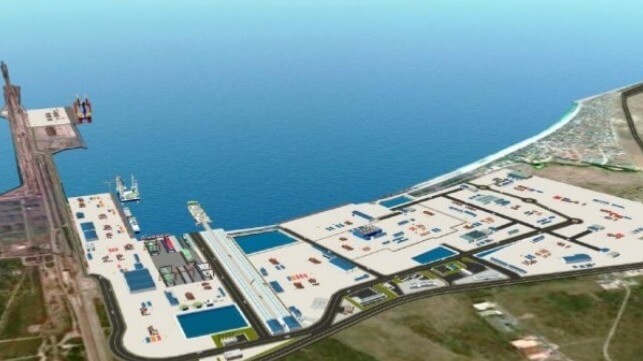Port of Saldanha Bay Could Boost South Africa's Container Capacity

Plans are underway in South Africa to develop an international business zone at the deep draft Port of Saldanha Bay, located 65 miles to the north of Cape Town, to provide for the transportation needs of the oil and gas industry. There may also be opportunity to develop container operations at Saldanha Bay.
Introduction
Prior to the opening of the Suez Canal in 1868, Cape Town served as an important port of call for the sailing ships that carried the spice trade between the East Indies and Europe. A century later, Cape Town gained significance in maritime transportation following the development of oil tanker ships that were too big to sail fully laden through the Suez Canal. The increasing size of oil tankers required the development of deep-draft ports in southern Africa, at Richards Bay and at Saldanha Bay.
Deep-draft bulk carriers transport coal and ore from South Africa’s mining industry via both of these ports. The discovery of offshore deposits of oil and natural gas off South Africa has prompted interest to develop the Port of Saldanha Bay to serve the offshore oil and natural gas industry with terminals and provide for repairs to bulk carriers. That initiative culminated in plans for International Development Zone located near the port. However, there has so far been little mention about future container operations at Saldanha Bay.
Container Operations
The Port of Durban is southern Africa’s busiest container port. Ongoing build-up of silt at the entrance to the port requires frequent dredging and restricts the size of container ship that can call there. In 2009, South Africa’s Transnet opened the Port of Ngqura located near the City of Port Elizabeth, where container ships that are too deep for either Durban or Cape Town may transfer containers. The increasing demand to move container traffic between Port of Durban and South Africa’s largest metropolis, Johannesburg, has prompted authorities to upgrade the railway line from Port of Ngqura.
South Africa’s 3-foot 6-inch “Cape gauge” railway gauge with overhead electrification is restricted to single-stacked container operation. Trains travel through multiple tunnels along railway line though Dragon Mountain (Drakensberg) between Durban and Johannesburg, and the line is operating near full capacity. An upgraded railway line between Port of Ngqura and Johannesburg provides urgently needed relief. Port of Ngqura was originally built to service neo-Panamax size container ships that incur lower per-container transportation costs across the ocean, than ships that call at Durban. However, the increase in railway distance over the Durban and Johannesburg also incurs higher railway transportation costs.
Cape Town
Cape Town is southern Africa’s most populous coastal city that incudes South Africa, Mozambique and Namibia. Port of Cape Town’s history dates back to 1862 when construction of a breakwater began. It was to provide a protected and sheltered harbor area after severe South Atlantic Ocean storms had previously destroyed ships anchored in Table Bay. Cape Town’s present day breakwater is a reinforced extension of the original 1862 breakwater. Table Bay was dredged beginning in the late 1930s to develop a harbor for large ships and to reclaim land from the sea, known as the foreshore area.
The approach to Cape Town harbor is shallower than the laden sailing draft of modern large container ships. Dredging the navigation channel might not be an option given the propensity of stormy seas to carry silt into that channel. A new extended breakwater might provide an expanded sheltered zone and prevent future buildup of silt. There may be a need to use dynamite to blast the seafloor to develop a deep-draft navigation channel to Cape Town docks and to deepen the container port. Both undertakings involve considerable expense with uncertain long-term viability.
By contrast, the Port of Saldanha Bay can already accommodate ships of 20 meters of draft (or more, with guidance from port authorities). A future container terminal at Saldanha Bay would easily berth deep-draft keels of the largest container ships. Tug-barge feeder operations could carry containers over the 65-mile distance to and from Cape Town. Cape Town’s economic competitiveness depends on close proximity to a deep-water container port, requiring Saldanha Bay to provide for the international container transportation requirements for businesses and industries located within the Greater Cape Town area. Saldanha Bay could offer repair services for large container ships, with future potential for container transshipment operations at Saldanha Bay connecting with West African ports extending to the equator.
A previous Mayor of Cape Town called for relocating maritime container operations to Saldanha Bay. Port of Cape Town has insufficient water depth to serve the large container ships that sail between Asia and South America. There will be need for feasibility studies and research to determine the performance of a new breakwater preventing future buildup of silt inside a deepened navigation channel and deepened harbor area. It would likely be less costly to modify the Port of Saldanha Bay to serve deep-draft container ships and provide container transfer operations using smaller vessels to connect to Cape Town.
The opinions expressed herein are the author's and not necessarily those of The Maritime Executive.
